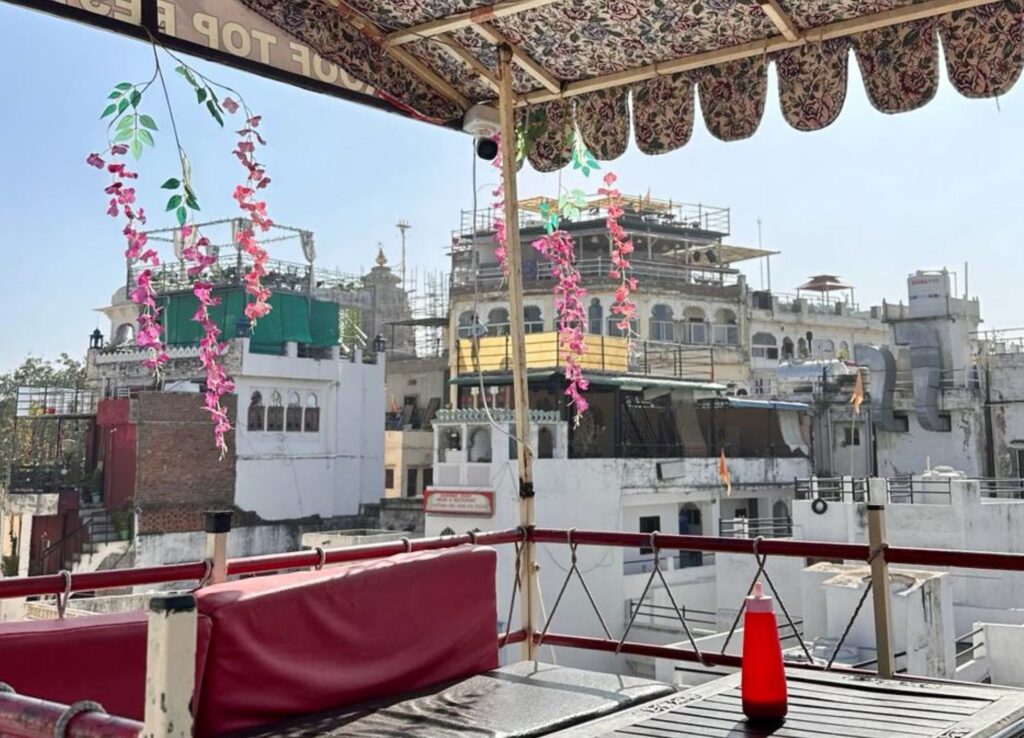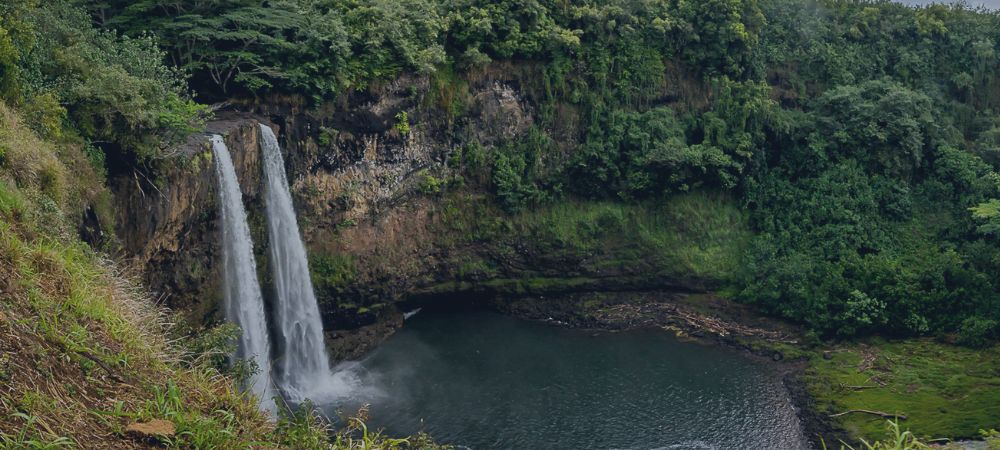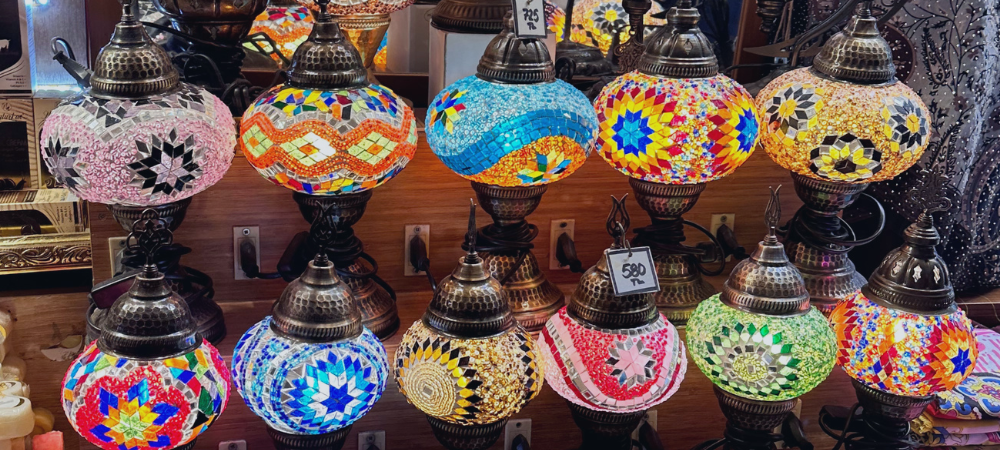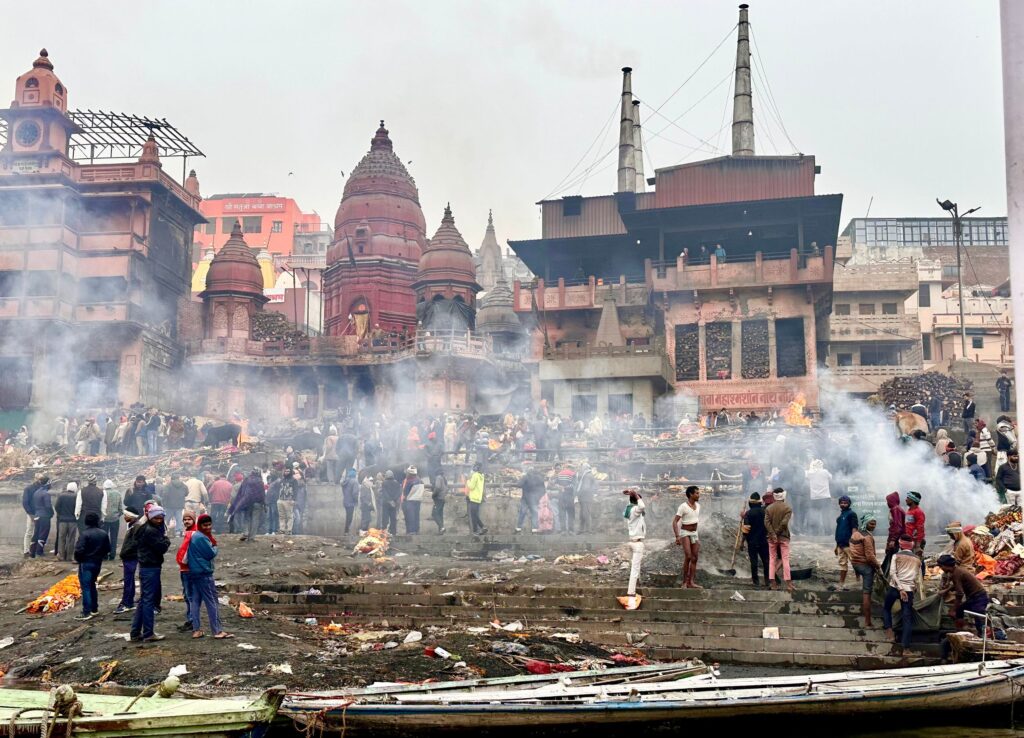Introduction to ‚2 Weeks North India Itinerary‘
Hey there fellow traveler!
Are you ready to dive into a new adventure that is North India? Hold on, because I’m here to guide you through an epic North India itinerary that’s going to blow your mind. We’re talking ancient cities, majestic palaces, serene landscapes, and everything in between. This North India itinerary isn’t just about making memories; it’s about experiencing life to the fullest. So, let’s not waste another minute and jump right in!
Are you considering a 2-week North India itinerary? You’re signing up for a rollercoaster of discovery, spirituality, and amazement. Every city on this North India itinerary offers a unique peek into the country’s vibrant soul, making every moment of your journey an unforgettable one.
Why to Choose North India for Backpacking?
Well, it’s for the fearless, the curious, and the ones who seek depth in their travels.
Backpacking through North India with a well-planned itinerary allows you to immerse yourself deeply in the land and its culture, connect with people on a meaningful level, and uncover the rich tapestry of India’s heritage.
From navigating ancient alleys, bargaining in lively markets, to sharing meals with locals, every experience enriches your North India itinerary with stories you’ll treasure forever.
A meticulously planned 2-week North India itinerary is the cornerstone of an incredible journey. It ensures you capture the essence of each destination without the rush. This North India itinerary is about striking the perfect balance between iconic sights, hidden gems, timeless traditions, and the contemporary pulse of the cities you’ll explore.
Don’t forget to check out our other India blog articles by following this link.
- Introduction to '2 Weeks North India Itinerary'
- Best Time to Travel to Northern India
- Recommended Places to Visit in Northern India
- What To Do In Northern India?
- How To Get Around Northern India?
- Your 2 Weeks North India Itinerary
- Frequently Asked Questions about Traveling in North India
- Conclusion on Your 2 Week North India Itinerary
Best Time to Travel to Northern India
Determining the best time to travel to Northern India is crucial for planning your journey, as the region experiences varied climatic conditions throughout the year. The optimal travel period hinges on what you aim to experience, the festivals you wish to participate in, and the regions you plan to explore.
This section will guide you through the ideal times for your 2 weeks North India itinerary, ensuring a memorable and comfortable journey. For a full guide about when’s the best time to travel to India, check out this blog post.
October to March: The Ideal Window
Winter (October to March) is widely regarded as the best time to visit Northern India. During these months, the weather is predominantly cool and pleasant, providing an ideal setting for sightseeing and exploration.
Temperatures range from a comfortable 12°C to 22°C, making it perfect for visiting the architectural marvels of Rajasthan, exploring the bustling streets of Delhi, or taking in the spiritual ambiance of Varanasi without the discomfort of extreme heat.
October and November offer the dual advantages of post-monsoon freshness and the onset of cooler temperatures. This period is also vibrant with festivals such as Diwali, the festival of lights, providing travelers with a unique insight into Indian culture and traditions.
December to February is ideal for those who prefer cooler climates. The chill in the air is more pronounced, especially in the evenings and early mornings. It’s a fantastic time for wildlife safaris in Ranthambore National Park, as the cooler weather increases the chances of spotting tigers and other wildlife.
March marks the beginning of spring and is characterized by a gradual increase in temperature. However, it remains a favorable month for travel, especially to witness the colorful festival of Holi, where locals and tourists alike partake in celebrations involving colored powders and water.
April to June: Extreme Heat
April to June are the months to avoid if possible, as temperatures soar, making outdoor activities and exploration challenging during the day. This period is considered the pre-monsoon summer, with temperatures frequently crossing 40°C, especially in the desert regions of Rajasthan and the urban landscapes of Delhi.
July to September: Monsoon Season
July to September is the monsoon season in Northern India. While the rains bring relief from the summer heat and the landscapes turn lush and green, heavy rainfall can disrupt travel plans, making it less ideal for those on a strict schedule. However, for the intrepid traveler, the monsoon season offers a unique perspective of Northern India, with fewer tourists and more attractive rates for accommodations.
Your 2 weeks North India backpacking itinerary should ideally be planned between October and March to make the most of the region’s cultural offerings and natural beauty under the most comfortable weather conditions.
Whether you’re drawn to the historical fortresses of Rajasthan, the spiritual ghats of Varanasi, or the bustling markets of Delhi, timing your visit during these months ensures an enriching and hassle-free experience.
Always check the local weather and festival calendar as part of your travel preparation to ensure you’re packing appropriately and ready to embrace the myriad experiences Northern India has to offer.
Especially in India it is more important than anywhere else to stay connected all the time. We basically used our phones for anything to look ig up on the internet or hailing a cab or tuktuk.
You can either get a local sim card or an eSIM which is much more practical than a physical sim. Check out Airalo, an eSIM provider offering plans starting from 5$ already.
Recommended Places to Visit in Northern India
A 2 weeks North India itinerary offers the experience of a region rich in history, culture, and natural beauty. From ancient cities to breathtaking landscapes, Northern India is home to a diverse range of destinations, each unique in its own way.
Here’s a guide to some of the most recommended cities and places to include in your North India backpacking itinerary, promising a blend of adventure, spirituality, and unforgettable experiences:
Varanasi: The Spiritual Heart of India
Varanasi, one of the world’s oldest inhabited cities, is a kaleidoscope of colors, scents, and sounds. Situated on the banks of the Ganges River, it’s a place where spirituality and life intertwine seamlessly. Key experiences include attending the Ganga Aarti ceremony, exploring the ancient ghats, and taking a boat ride at dawn to witness the city awaken.

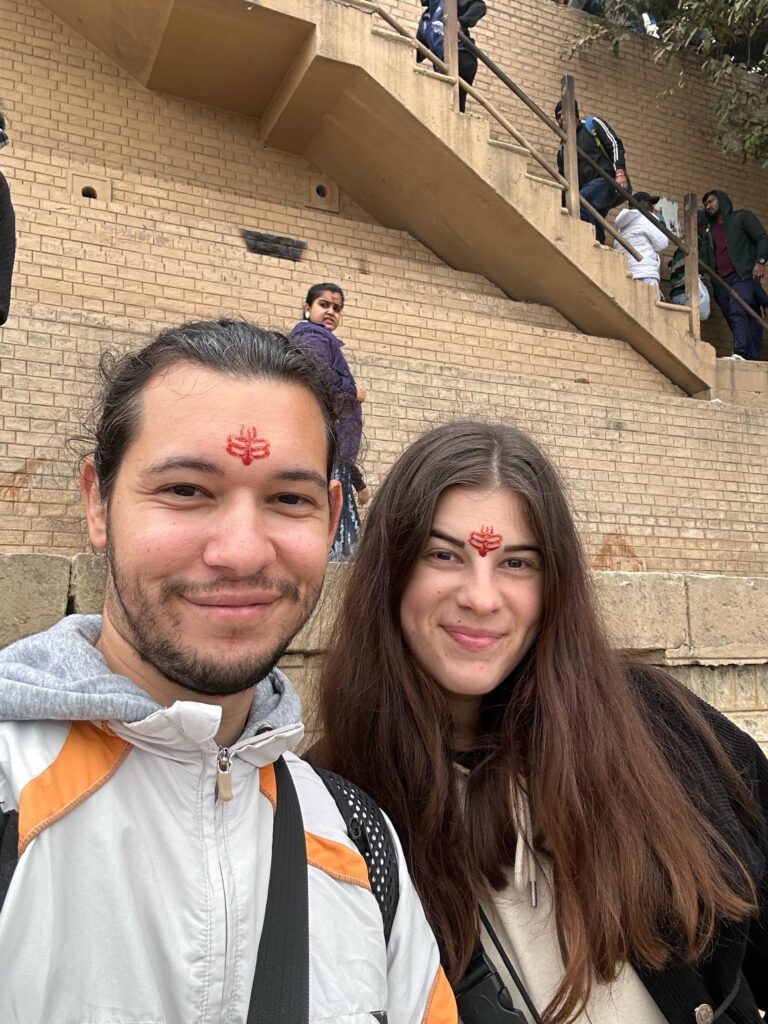
Agra: Home of the Taj Mahal
No trip to North India is complete without visiting the iconic Taj Mahal in Agra. This monument of love, built by Emperor Shah Jahan in memory of his wife Mumtaz Mahal, is a UNESCO World Heritage site and one of the New Seven Wonders of the World. Agra Fort and Fatehpur Sikri are other must-visit historical sites that offer a glimpse into India’s rich Mughal heritage.
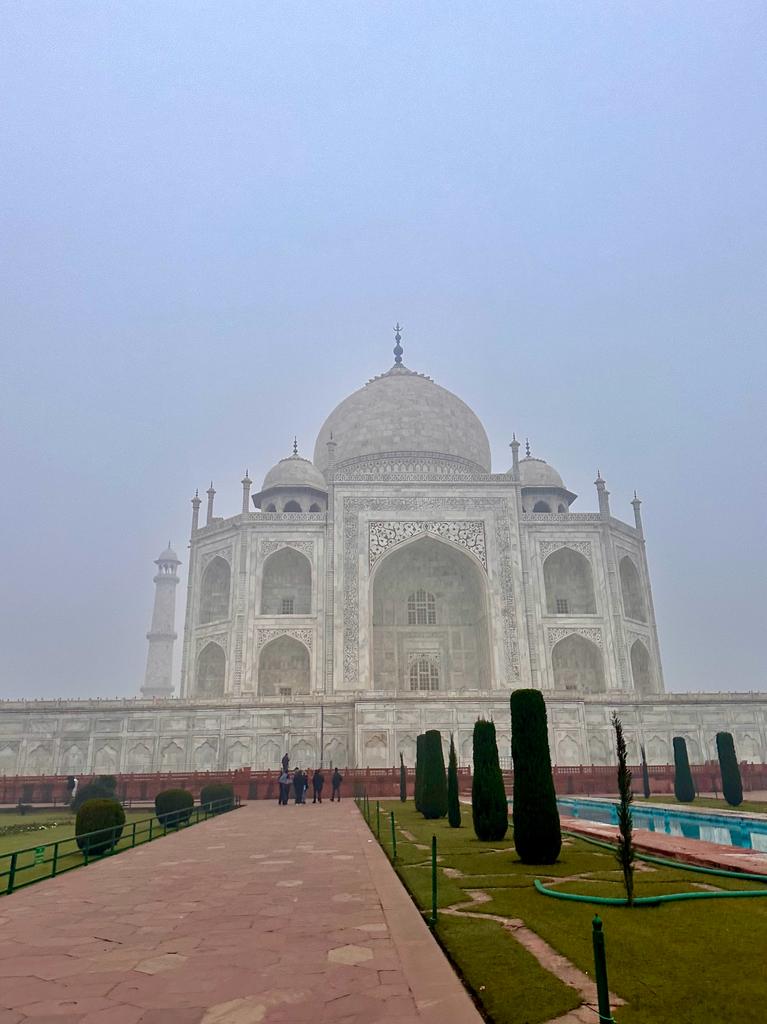

Ranthambore National Park: A Wildlife Adventure
For nature enthusiasts and wildlife photographers, Ranthambore National Park is a dream destination. Once a royal hunting ground, it’s now one of the best places in India to spot tigers in their natural habitat. The park also boasts a rich diversity of flora and fauna, making it a perfect addition to your North India backpacking itinerary.
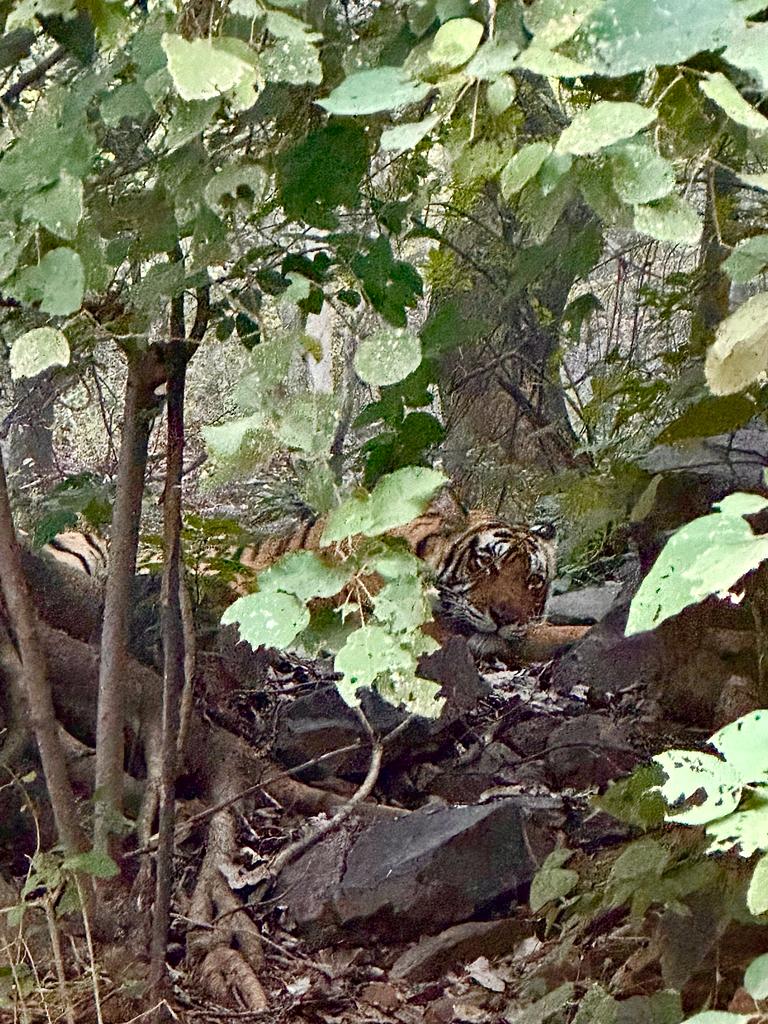
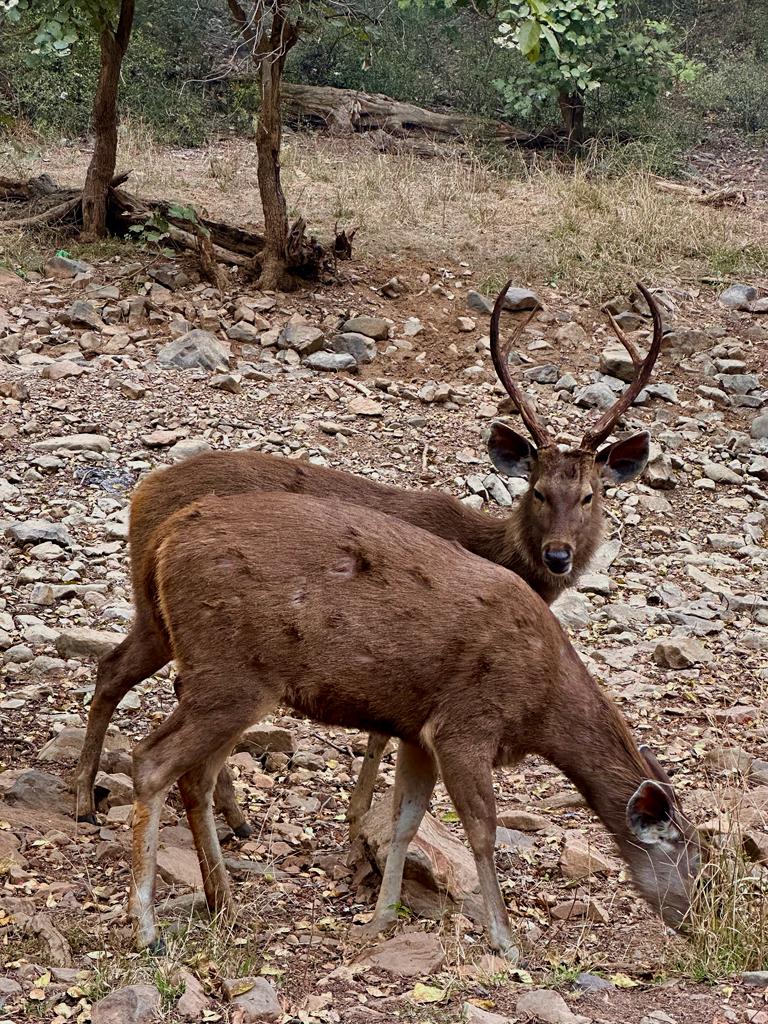
Udaipur: The City of Lakes
Udaipur, known as the Venice of the East, is famed for its stunning lakes and majestic Rajput-era palaces. The City Palace, overlooking Lake Pichola, and the beautiful Jagdish Temple are highlights. Enjoy a boat ride on Lake Pichola, capturing the serene beauty of the city and its surrounding landscapes.
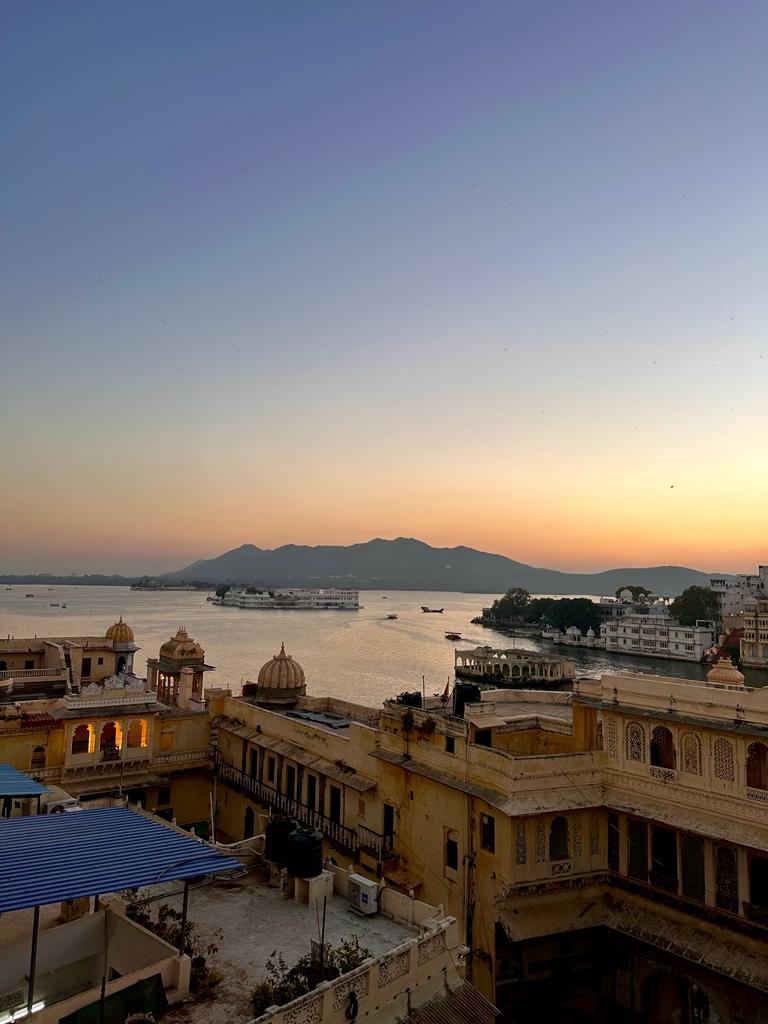
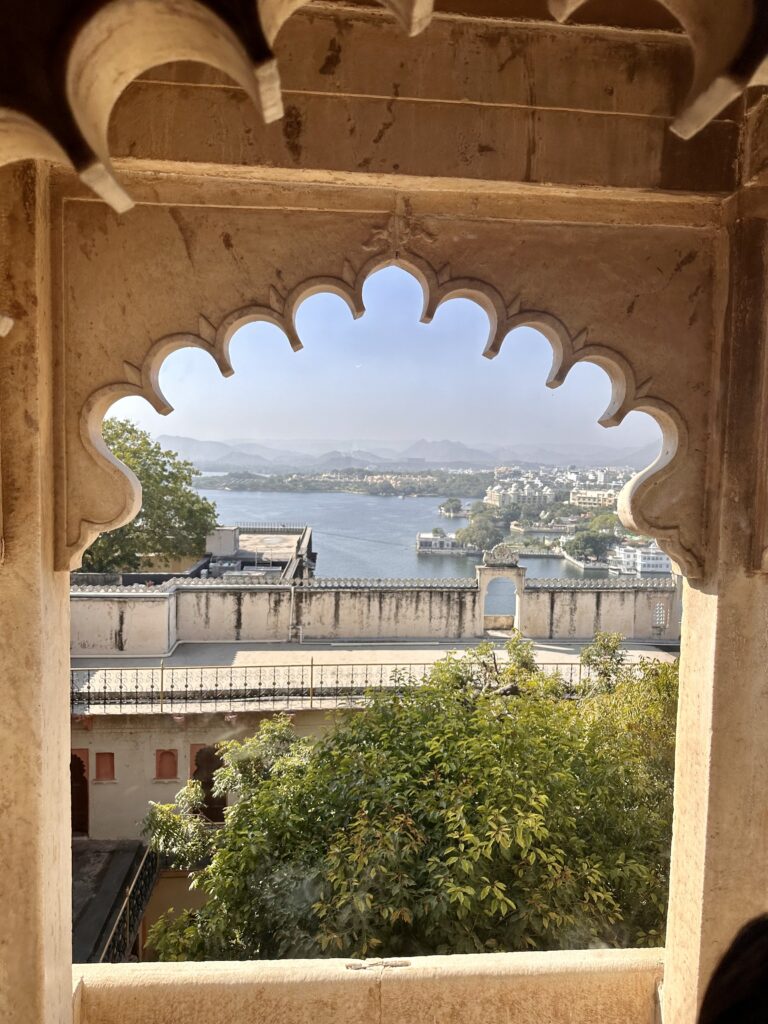
Jaisalmer: The Golden City
Jaisalmer stands on the edge of the Thar Desert, its golden sandstone architecture glowing in the sun. The Jaisalmer Fort, a living fort with homes, shops, and temples, is its centerpiece. Venture into the desert for a camel safari and overnight camping under the stars for an unforgettable experience.
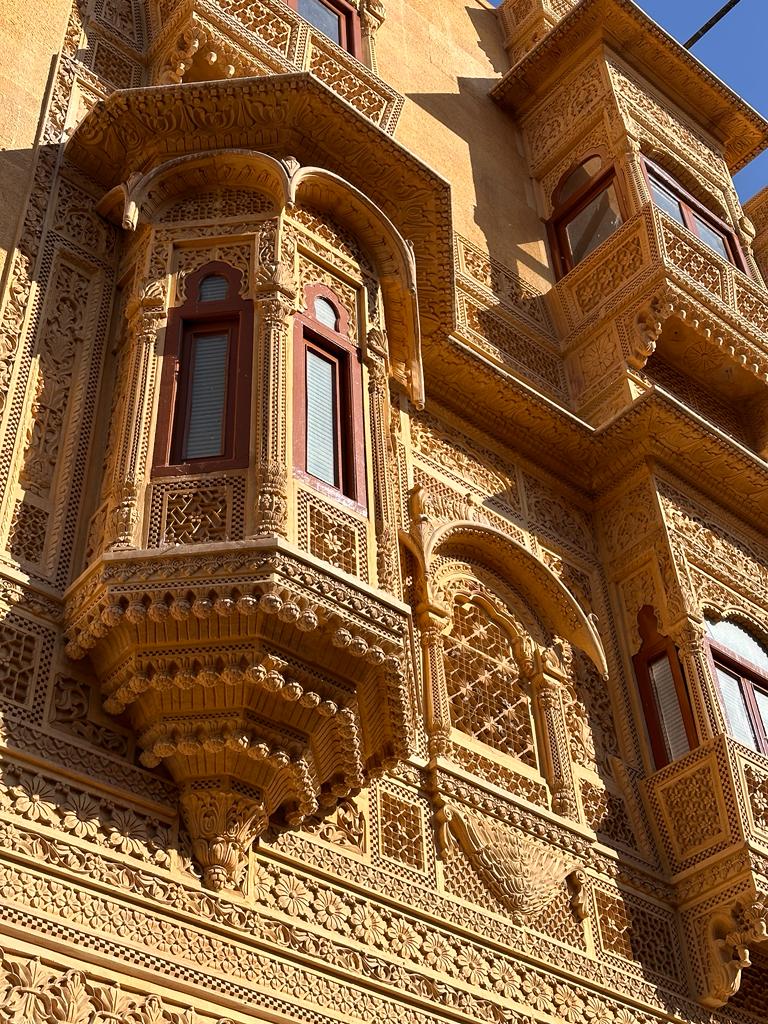
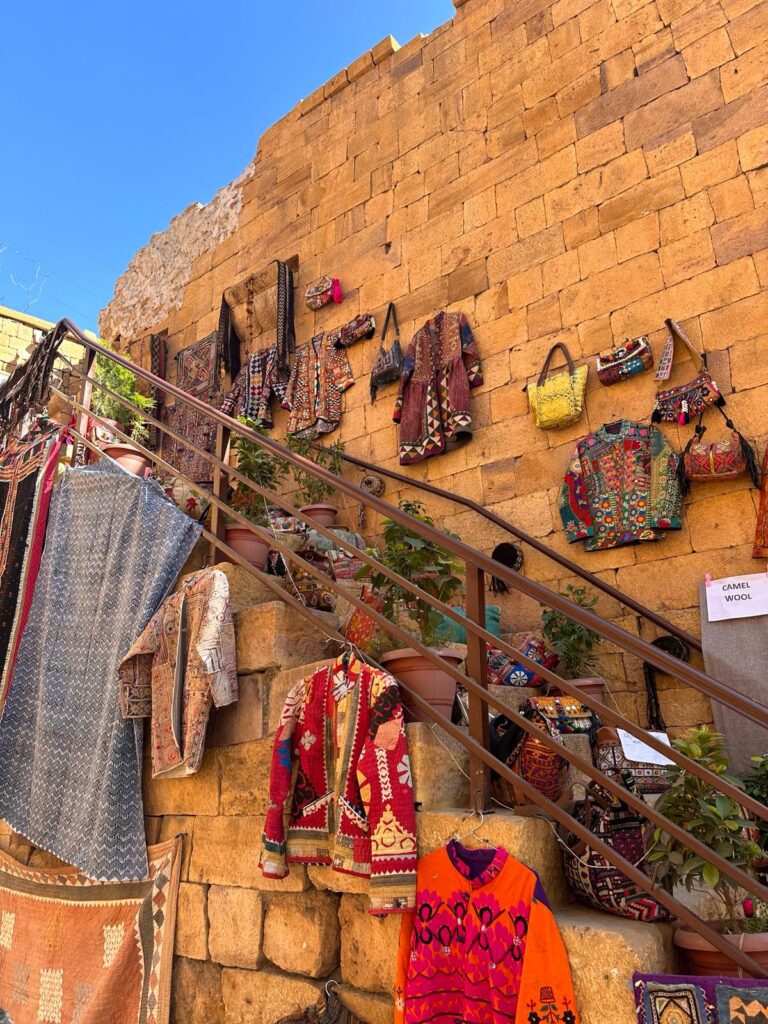
Jodhpur: The Blue City
Jodhpur’s blue-painted houses, set against the stark backdrop of the Thar Desert, offer an enchanting sight. The mighty Mehrangarh Fort dominates the cityscape, providing stunning views and housing an excellent museum. The winding streets of the old city are perfect for exploring the local culture and cuisine.
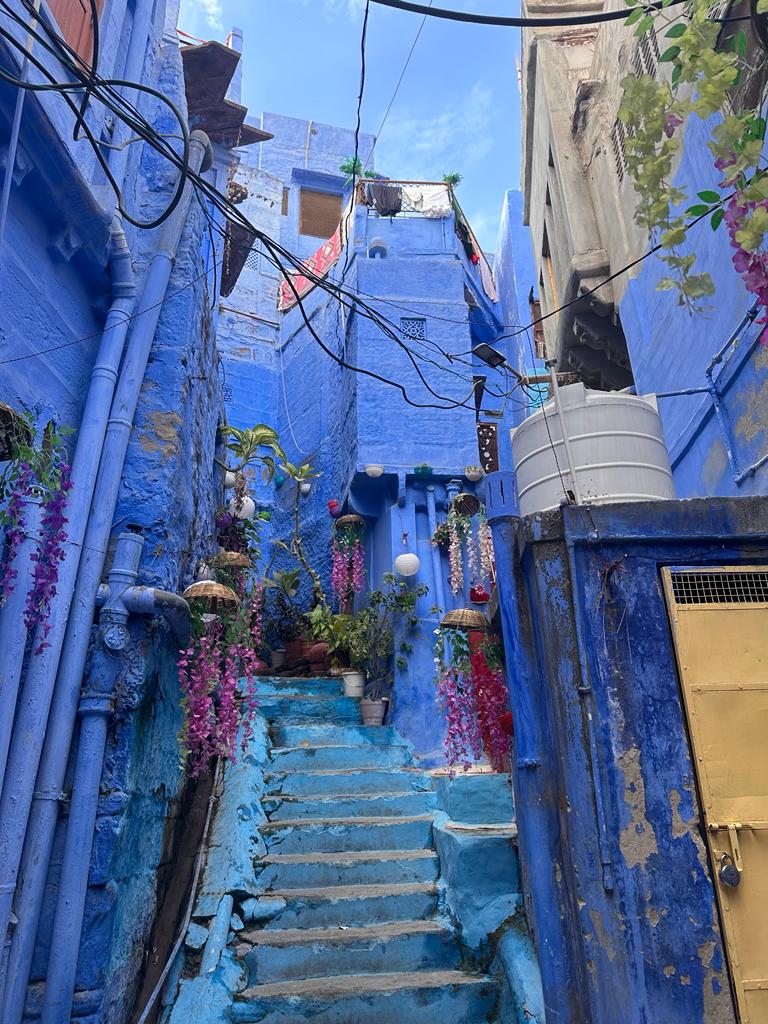
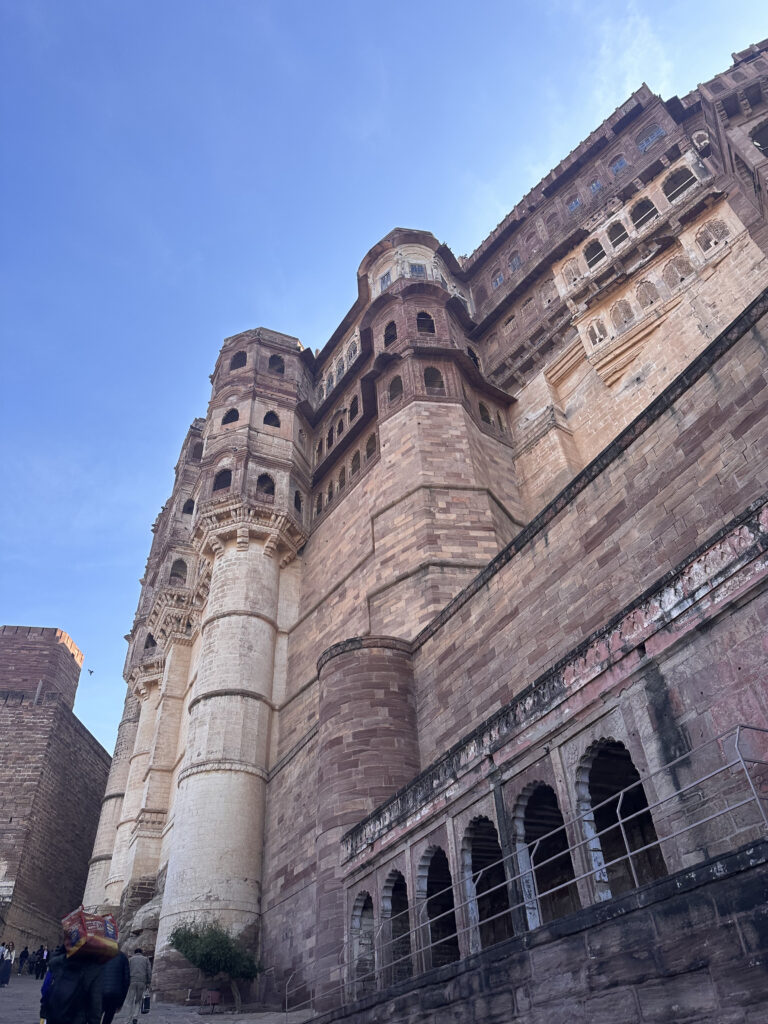
Jaipur: The Pink City
Jaipur, the capital of Rajasthan, is renowned for its rich history, culture, and architectural marvels, including the Amber Fort, City Palace, and Hawa Mahal. The bustling bazaars offer traditional textiles, jewelry, and handicrafts. Jaipur serves as a gateway to other Rajasthani destinations, making it a pivotal stop on your itinerary.
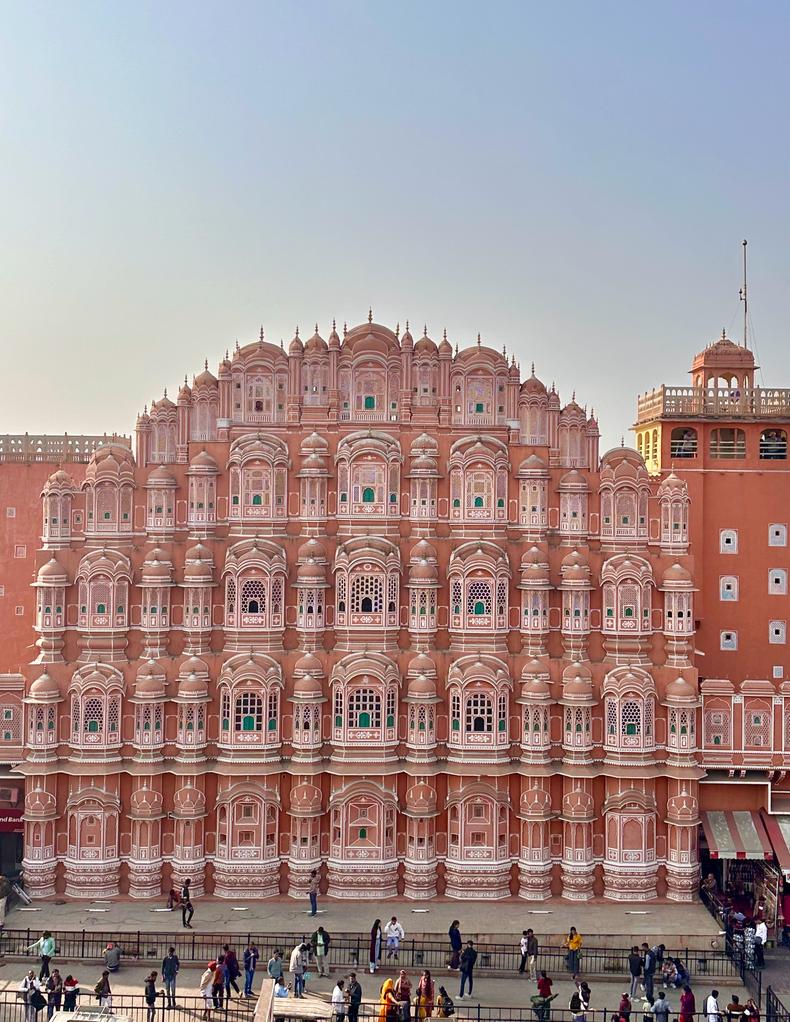
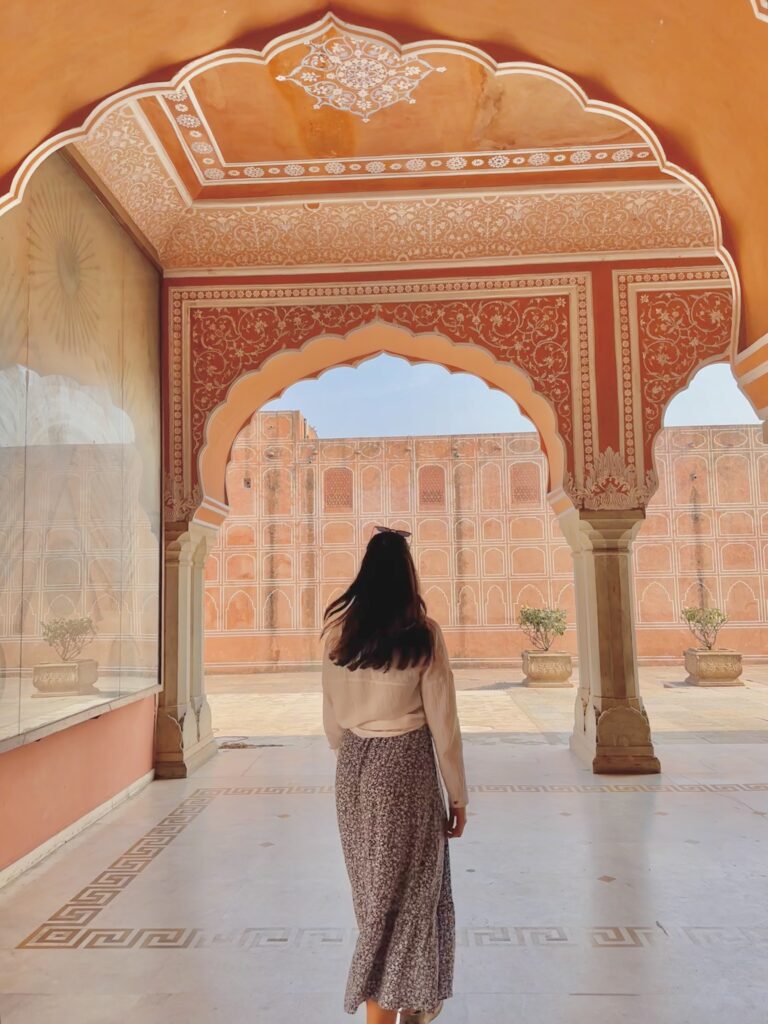
Delhi: The Capital’s Melting Pot
Delhi, India’s capital, offers a perfect blend of historic and modern. From the historical sites like the Red Fort and Humayun’s Tomb to the bustling streets of Chandni Chowk and the tranquility of the Lotus Temple, Delhi provides a diverse set of experiences. The city is also a culinary heaven, offering everything from street food to international cuisines.
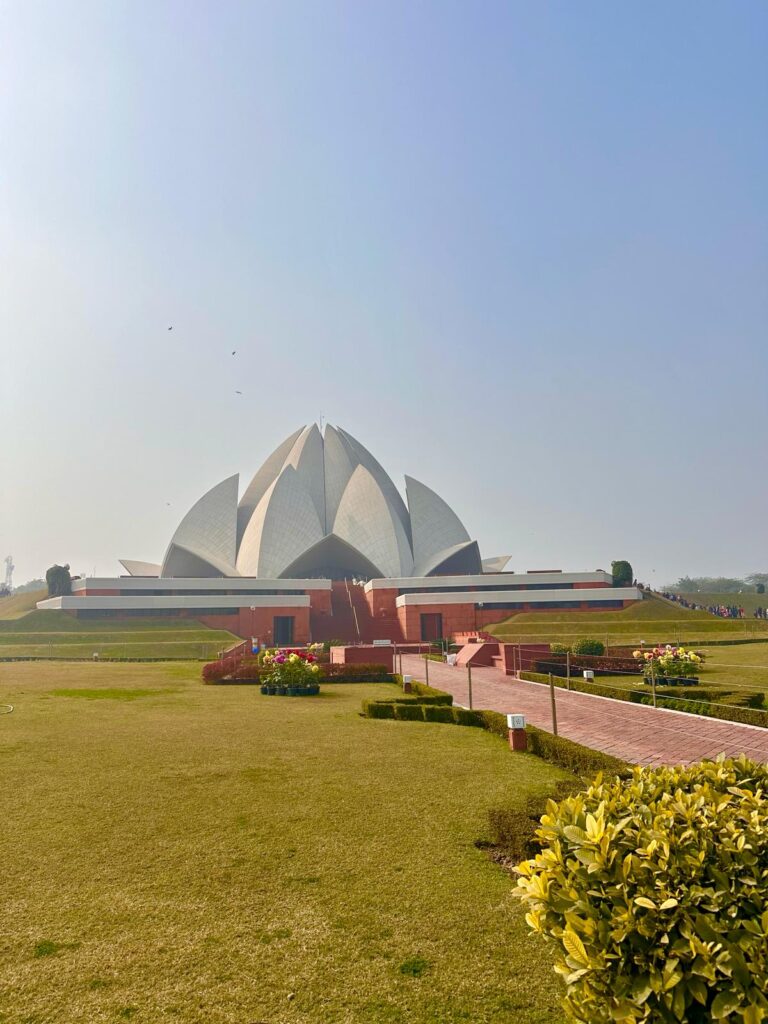
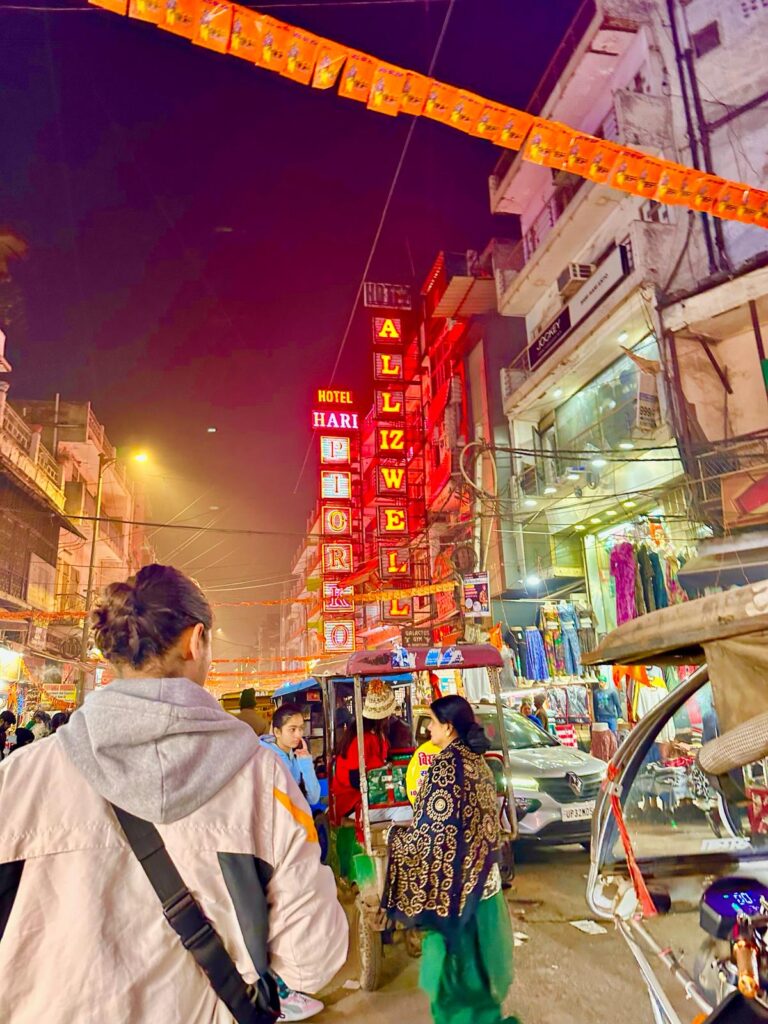
Incorporating these cities and places into your 2 weeks North India itinerary ensures a journey filled with diverse experiences, from the spiritual to the adventurous, the historical to the natural. Each destination offers a unique perspective on the vast tapestry that is India, promising memories that will last a lifetime.
What To Do In Northern India?
Embarking on a 2 weeks North India itinerary opens the door to a plethora of special experiences that transcend the ordinary, offering immersive ways to connect with the region’s culture, history, and landscapes. These unique experiences enrich your journey, turning it into an unforgettable adventure:
Attending the Ganga Aarti in Varanasi
The Ganga Aarti at Varanasi is a spiritual spectacle of light and devotion, held every evening on the ghats of the sacred Ganges River. Participating in or witnessing this ritual offers a profound sense of peace and spirituality, as chants and prayers fill the air, and countless small lamps float on the river.
We did this full-day Varanasi tour and it was worth every single penny!
Taj Mahal at Sunrise
Witnessing the Taj Mahal at sunrise is an ethereal experience. The early morning light bathes the marble monument in a soft glow, highlighting its architectural beauty and the love story it embodies. This moment allows for contemplation and appreciation away from the crowds.
Book your day-trip from Delhi to Agra here (including Taj Mahal, Red Fort and many more buildings)
Tiger Safari in Ranthambore National Park
A safari in Ranthambore National Park is not just about spotting tigers; it’s an adventure into the wild, offering glimpses of various species in their natural habitat. The excitement of tracking a tiger, coupled with the beauty of the park’s landscapes, makes for an exhilarating experience.
Follow this link to book your Tiger Safari starting in Jaipur.
Sunset Boat Ride on Lake Pichola, Udaipur
Udaipur’s charm is best experienced from the waters of Lake Pichola. A sunset boat ride offers stunning views of the city’s palaces and ghats, with the setting sun painting everything in golden hues. It’s a peaceful experience that showcases the city’s romantic side.
A simple boat ride can be booked via the following link.
Desert Safari and Overnight Camping in Jaisalmer
Exploring the Thar Desert on a camel safari and spending the night under the stars in a desert camp near Jaisalmer is an unforgettable adventure. It provides a glimpse into the desert lifestyle, complete with folk music, dance, and traditional freshly-cooked Rajasthani cuisine.
Exploring the Blue City of Jodhpur
Walking through the blue-painted streets of Jodhpur offers an intimate look at the city’s architecture and daily life. Visiting the Mehrangarh Fort for panoramic views and exploring the bustling markets are special experiences that capture the essence of Jodhpur.
Here you can check-out a walking tour through the Blue City.
Hot Air Balloon Ride over Jaipur
A hot air balloon ride at dawn over Jaipur offers a unique perspective of the city’s forts, palaces, and surrounding landscapes. The tranquility of floating above, coupled with the breathtaking views, makes this a once-in-a-lifetime experience.
Check out the hot air ballon experience here!
Culinary Tour in Delhi
Delhi is a melting pot of culinary traditions from across India. A guided food tour through areas like Chandni Chowk allows you to taste a variety of street foods, learn about the city’s food culture, and discover hidden gastronomic gems.
Each of these experiences adds depth to your 2 weeks North India itinerary, offering not just sights to see, but memories to cherish. Whether it’s the tranquility of a spiritual ceremony, the thrill of wildlife spotting, the romance of a sunset, or the joy of tasting new flavors, North India promises adventures that resonate long after the journey ends.
You can find many of these tours on GetYourGuide or Viator, my go-to platforms when it comes to booking unique activites worldwide!
How To Get Around Northern India?
Navigating the vast and diverse landscapes of North India requires a mode of transportation that is not only reliable but also offers an authentic experience of the country’s geographic and cultural fabric.
While buses connect various destinations across North India, trains are often the preferred mode of transportation for those looking to explore the region’s heart and soul on a 2 weeks North India itinerary.
If you want to read our full train travel guide, feel free to follow this link here for more detailed information!
Train travel in India is more than just a means of transportation; it’s an integral part of the adventure that allows you to witness the country’s changing landscapes and interact with locals.
Indian Railways, one of the world’s largest rail networks, offers extensive connectivity across North India, making it possible to travel from the bustling cities to the serene countryside efficiently and comfortably.
Advantages of Train Travel
Traveling India by train is not complicated and definitely an experience you shouldn’t miss out on! Here are some advantages why traveling by train is a no-brainer:
- Scenic Routes: Trains journey through diverse terrains, offering windows to India’s soul. From the mustard fields of Punjab to the sandy deserts of Rajasthan and the Ganges plains, train travel provides a panoramic view of the country’s natural beauty.
- Cultural Immersion: Sharing a compartment with locals is an opportunity to immerse yourself in Indian culture. It’s a chance to exchange stories, share food, and gain insights into the Indian way of life.
- Safety and Comfort: Trains offer various classes of travel, from luxurious AC coaches to economical sleeper classes, catering to all budgets while ensuring safety and comfort.
- Eco-Friendly: Train travel is one of the most sustainable modes of transportation, significantly reducing the carbon footprint compared to air or road travel.
- Cost-Effective: Train tickets are economically priced, offering an affordable way to cover long distances, which is particularly beneficial for backpackers and budget travelers.
Planning Your Train Journey
To make the most of your train travel experience in North India, good planning is key. Here are some essential tips for this experience:
- Advance Bookings: Trains in India can get fully booked well in advance, especially during peak travel seasons and festivals. It’s advisable to book your tickets as early as possible, using platforms like the IRCTC website or mobile apps.
- Choosing the Right Class: Depending on your comfort level and budget, you can choose from various classes such as AC First Class, AC 2 Tier, AC 3 Tier, Sleeper Class, and more. Each class offers different amenities and levels of comfort. I would suggest to travel with AC2 Tier only!
- Night Journeys: Opting for overnight trains can save you the cost of a hotel night and maximize your daytime for exploration. It’s an efficient way to cover long distances, waking up to a new destination ready for adventure.
- Packing for the Journey: Bringing your own water, snacks, and a travel pillow can make your train journey more enjoyable. Although food is available on long-distance trains, having some essentials can come in handy.
Alternative: Buses – But with Caution!
While buses offer another option for getting around, it’s worth noting that the experience might not always meet expectations in terms of comfort and reliability. Given the vast distances and sometimes challenging road conditions in North India, trains provide a more comfortable and enjoyable travel experience, particularly for those on a 2 weeks itinerary.
Our experience with busses were horrible. The drivers drove like crazy, the highways are bumpy so we often hitted our heads against the ceilings and since it was an overnight ride, we didn’t get any sleep. Traveling by train is much more relaxed, promise!
Travel Durations For This Route
In the following you will see the duration of the trains to get from one to another city on this route. Note that these are approximate times and there might happen delays too! When we visited Northern India in December 2023 / January 2024 there was an unusual high amount of fog all over Northern India which is why we had mostly delays between 1 and 5 hours!
- Delhi to Varanasi: 8 hours
- Varanasi to Agra: 7 hours
- Agra to Sawai Madhopur (Ranthambore NP): 3.5 hours
- Sawai Madhopur to Udaipur: 7 hours
- Udaipur to Jaisalmer: 8 hours (by bus)
- Jaisalmer to Jodhpur: 5 hours
- Jodhpur to Jaipur: 4.5 hours
- Jaipur to Delhi: 4.5 hours
In conclusion, train travel in North India is not just a mode of transportation but a highlight of the journey itself, offering a glimpse into the heart of India’s landscapes and culture. With careful planning and an open spirit, train journeys can enhance your North India backpacking itinerary, making every moment aboard part of your adventure story.
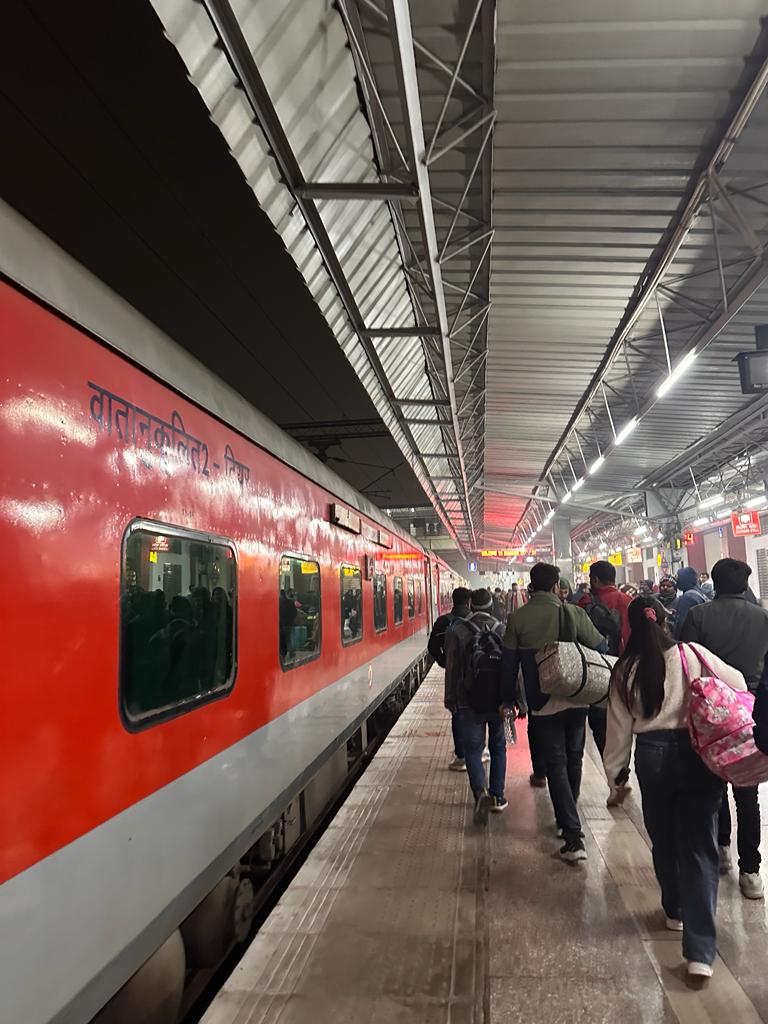
For seamless travel across the country, consider using 12AsiaGo and Busbud to book your transportation. Whether it’s trains, or buses, these platforms offer convenient options to ensure you reach your destinations comfortably and on time.
Your 2 Weeks North India Itinerary
This guide wouldn’t be complete if I wouldn’t share the most amazing North India Itinerary with you! So here is the route we did in 3 weeks but I cut it down to 15 days:
15 Day Route
1 day Varanasi → 2 days Agra → 2 days Ranthambore Nationalpark → 2 days Udaipur → 2 days Jaisalmer → 2 days Jodhpur → 2 days Jaipur → 1 day Delhi
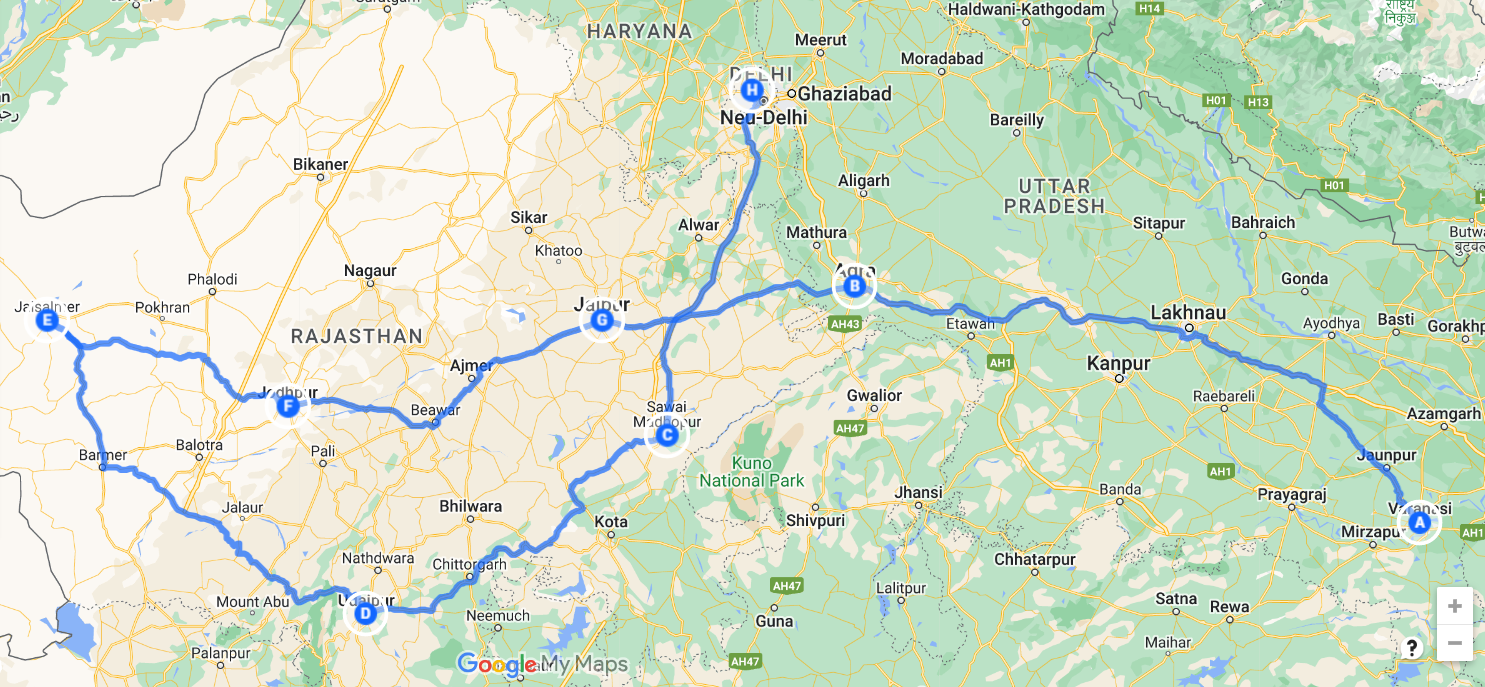
Day 1: Varanasi
Exploring Varanasi, often referred to as the spiritual heart of India, offers a rich tapestry of cultural and religious experiences. This ancient city, nestled along the banks of the Ganges River, is a key destination for those embarking on a 2 weeks North India itinerary. A detailed Varanasi guide can be found here.
What to Do in Varanasi
- Explore the Ghats: Varanasi’s riverbanks are adorned with pavilions, palaces, and temples, offering a serene yet vibrant atmosphere. The ghats, with their stone steps leading to the river, are central to the city’s life. Each ghat has its unique significance and beauty, making a walk or boat ride along them a must-do. Make sure to visit one of the Burning Ghats.
- Boat Ride at Dawn: A pre-dawn boat ride on the Ganges is an unforgettable experience. Witnessing the sunrise and observing the city come to life offers a profound sense of peace and spirituality.
- Old City Maze: The heart of Varanasi lies in its narrow, bustling alleys. Exploring this area allows you to immerse yourself in the city’s ancient architecture and vibrant street life.
- Durga Temple: Also known as the Monkey Temple, this site is notable for its red ochre color and the lively monkeys that inhabit its surroundings.
- Tulsi Manas Temple: Open to all, this temple is famed for its walls inscribed with verses from the Ramcharitmanas.
- Bharat Kala Bhawan Museum: Located in the Banaras Hindu University, it houses a rich collection of art, showcasing the city’s history and culture.
- Ramnagar Fort: Across the Ganges, this fort offers a historical insight into the regal past of Varanasi with its museum and impressive architecture.
Where to Eat
Varanasi’s culinary scene is a blend of street food delights and traditional Indian cuisines. The city is famous for its chaat, kachoris, and lassi. The streets near the ghats, such as Dashashwamedh Ghat and Assi Ghat, are lined with vendors and eateries serving local delicacies. Our favorite restaurants are Aman-E-Khaas and Eatery Restaurant.
Where to Stay
Accommodation options in Varanasi range from hostels and guest houses for budget travelers to mid-range and luxury hotels for those seeking more comfort. Key areas to consider staying in include:
- Dasaswamedha Ghat: Central to Varanasi’s religious activities, offering easy access to the Ganga Aarti and the river.
- Assi Ghat: A quieter area with a mix of accommodations, ideal for those looking for a more relaxed stay.
- Shivala and Hanuman Ghat: Offer a range of hotels and guesthouses with views of the Ganges.
- A high-budget hotel is for example New Hotel Broadway
- For low-budget stays we can recommend South Villa Guesthouse.
When it comes to finding the perfect stay for any budget, Hostelworld and Agoda have got you covered! Explore a variety of accommodations, from cozy guesthouses to luxurious hotels, making your journey even more comfortable.
🚆 Transportation: From Varanasi to Agra it takes about 7 hours by train 🚆
Day 2 & 3: Agra
Agra, the city that houses the iconic Taj Mahal, is an essential stop on any 2 weeks North India itinerary. This city, located on the banks of the Yamuna River, is not only about its famous monument but also offers a deep dive into India’s rich Mughal heritage with its forts, palaces, and mausoleums.
What to Do in Agra
- Taj Mahal: The epitome of love, this white marble mausoleum is a must-visit. Its architectural beauty and the story behind its construction are mesmerizing. Early morning visits are recommended for fewer crowds and a magical view at sunrise.
- Agra Fort: Another UNESCO World Heritage Site, this red sandstone fortress presents a mix of architectural styles and offers insight into the lavish lifestyle of the Mughal emperors.
- Itimad-ud-Daulah (Baby Taj): Often referred to as the precursor to the Taj Mahal, this tomb boasts intricate marble lattice work and fine inlay details, set within beautiful gardens.
- Sikandra / Akbar’s Tomb: The tomb of the great Mughal Emperor Akbar, combines Islamic, Hindu, Buddhist, Jain, and Christian motifs, reflecting Akbar’s philosophy of religious tolerance.
- Shopping: Agra is famous for its marble inlay work, leather goods, and carpets. Explore Kinari Bazaar and Sadar Bazaar for the best shopping experience, but be cautious of credit-card fraud and inflated prices due to commissions.
Where to Eat in Agra
Agra’s culinary scene offers a mix of Mughalai delicacies, street foods, and international cuisines. Pinch of Spice and Esphahan at The Oberoi Amarvilas are highly recommended for a fine dining experience featuring local and traditional dishes.
Where to Stay in Agra
- Luxury: The Oberoi Amarvilas stands out for its unparalleled views of the Taj Mahal and exquisite service. ITC Mughal is another excellent choice, offering luxury with a blend of Mughal and contemporary styles.
- Mid-Range: Areas like Taj Ganj and Fatehabad Road host several comfortable hotels that offer good value for money, such as Hotel Kamal and Hotel Saniya Palace, some of which boast views of the Taj.
- Budget: For backpackers, Moustache Hostel provides a safe and sociable environment, ideally located for exploring the city.
🚆Transportation: From Agra to Ranthambore it takes about 3 hours by train 🚆
Day 4 & 5: Ranthambore National Park
Ranthambore National Park, a renowned wildlife sanctuary in Rajasthan, India, is celebrated for offering one of the best tiger sightings in the world. This park is not just about tigers; it hosts a variety of wildlife, making your safari an unforgettable experience. For a detailed article about Ranthambore Nationalpark and Tiger Safari, follow this link.
What to Do in Ranthambore
- Jeep Safari: Opt for a jeep safari for a more intimate and flexible wildlife viewing experience. Jeeps accommodate up to 6 people and offer a better chance for animal sightings, including the elusive Bengal tiger.
- Canter Safari: A more economical option, canter safaris are conducted on larger vehicles accommodating 20 passengers. Though less personal, it’s a viable option for solo travelers or those on a tight budget. Check out the official Nationalpark website for further information.
- Visit Ranthambore Fort: Explore this UNESCO World Heritage site located within the park for a glimpse into India’s rich history and stunning views over the park
- Village Women Craft: Support local craftsmanship by visiting this initiative that empowers women through traditional craft making.
Where to Stay in Ranthambore
Accommodations range from budget-friendly options to luxury resorts. Options like the Ranthambore Mahal and The Vantage Haveli are great for those on a budget, while Ranthambore Tiger Valley and Khem Villas offer mid-range and luxury stays, respectively.
Where to Eat in Ranthambore
Our two favorite restaurants are Ranthambore Restaurant & Café and Skyza Rooftop Lodge Restaurant.
🚆You can get from Sawai Madhopur (Ranthambore NP) to Udaipur in 7 hours by train 🚆
Day 6 & 7: Udaipur
Udaipur, often called the „Venice of the East,“ is a city of picturesque lakes, splendid palaces, and vibrant bazaars. Its romantic ambiance is complemented by the Aravalli hills, making it a must-visit on your 2 weeks North India itinerary. If you want to do only one day in Udaipur, this full-day tour got you covered with the essential must-visit destinations!
What to Do in Udaipur
- City Palace: A monumental complex offering a deep dive into the royal heritage of Rajasthan with its exquisite rooms, courtyards, and stunning views over Lake Pichola.
- Lake Pichola: Enjoy a tranquil boat ride on this artificial lake, especially enchanting at sunset, to see the city in its best light.
- Jagdish Temple: This large and artistically significant temple is an architectural marvel with intricate carvings, dedicated to Lord Vishnu.
- Bagore Ki Haveli: Located on the waterfront of Lake Pichola, this haveli turns into a vibrant venue for traditional dance and music performances in the evening.
- Jag Mandir: An island palace in Lake Pichola, known for its beautiful architecture and grandeur, accessible by boat.
- Bahubali Hills: This is a trending destination outside of Udaipur and surrounded by lakes. It’s just a 20 minute cab ride away.
Where to Stay in Udaipur
- The Oberoi Udaivilas: Renowned for its luxurious ambiance and exceptional service, offering stunning views of Lake Pichola.
- Taj Lake Palace: Situated in the middle of Lake Pichola, this hotel offers exclusive royal experiences, perfect for those looking to splurge.
- Hotel Green View Ranthambore: A budget-friendly option with decent amenities and courteous staff, starting at 1200 INR
- Travel Soul Bed & Breakfast: Offers a cozy stay starting at 1400 INR, ideal for those seeking comfort without breaking the bank
Where to Eat in Udaipur
For a traditional Rajasthani thali, Natraj Dining Hall and Restaurant and Krishna Dal Bati Restro come highly recommended. Jheel’s Ginger Coffee Bar & Bakery offers a relaxed atmosphere with views over Lake Pichola, perfect for a leisurely coffee or shake.
For those seeking a romantic dining experience, Ambrai – Amet Haveli provides an exquisite lakeside setting, priced at Rs1700 for two. Upre by 1559 AD offers rooftop dining with mesmerizing views of the city and lake, a meal for two estimated at Rs1900.
Udaipur’s charm lies in its ability to blend historical grandeur with natural beauty, making every moment in this city unforgettable. From exploring ancient palaces and temples to relaxing by the lakeside and savoring local cuisine, Udaipur promises an experience rich in culture and beauty.
Follow this link for our favorite rooftop restaurants in Udaipur.
🚍 You can get from Udaipur to Jaisalmer by bus in 9 hours. I don’t know if there’s a direct train operating, they might be going to Jodhpur first and then you have to switch trains. This is the reason why we took a bus, but I can’t really recommend that 🚍
Day 8 & 9: Jaisalmer
Jaisalmer, the „Golden City,“ is a desert wonderland that captivates with its yellow sandstone architecture, sprawling fort, and vibrant culture. This city, nestled in the heart of the Thar Desert, offers a unique blend of historical richness and adventurous desert experiences.
What to See and Do in Jaisalmer
- Patwon ki Haveli: A cluster of five intricately designed mansions built by a wealthy merchant for his sons. The haveli is renowned for its museum and beautiful architecture.
- Jaisalmer Fort: Also known as Sonar Qila, this living fort is made of yellow sandstone and houses a bustling community along with temples, shops, and restaurants. Entry is free, making it a must-visit.
- Jain Temples: Located within the Jaisalmer Fort, these temples are famous for their detailed carvings and contain statues of the 24 Jain Tirthankaras.
- Gadisar Lake: A manmade lake ideal for a peaceful boat ride, especially beautiful at sunset. The lake’s shore is adorned with temples and pavilions.
- Salim Singh ki Haveli: Known as the Peacock Haveli, this architectural marvel showcases the unique roof shaped like a peacock, making it a fascinating visit
- Camel Safari in the Thar Desert: Experience the desert life with a camel safari, witnessing the serene beauty of the sand dunes, possibly staying overnight in a desert camp for a stargazing session. If you want to get to know more about a desert safari, read further.
Where to Stay in Jaisalmer
- Suryagarh Jaisalmer: Offers luxurious accommodation with a blend of modern and traditional architecture, ensuring a royal experience in the desert
- Jaisalmer Marriott Resort & Spa: Provides high-end amenities and comfort, making your stay memorable with its exceptional service and elegant rooms
- The Gulal: A budget-friendly option that doesn’t compromise on comfort and Rajasthani hospitality
- Moustache Jaisalmer: Located near the Jaisalmer Fort, offering both private rooms and dorms around a traditional verandah, making it an ideal choice for backpackers
Where to Eat in Jaisalmer
Jaisalmer’s cuisine is a delightful mix of Rajasthani flavors with a hint of rich non-vegetarian dishes. For traditional delicacies like Ker Sangri, Gatte ki Sabji, and Dal Bati Churma, Desert Boy’s Dhani is highly recommended.
For a taste of local non-vegetarian cuisine, including the famous Murgh-e-subz, The Trio is a must-visit. For those looking for a variety of cuisines, Jaisal Italy offers excellent Italian dishes, while Gaji’s Restaurant is known for its Korean food
🚆 It takes about 5 hours to get from Jaisalmer to Jodhpur 🚆
Day 10 & 11: Jodhpur
Jodhpur, famously known as the Blue City, offers a vibrant tapestry of history, architecture, and culture against the backdrop of the Thar Desert. Its blue-painted houses, towering forts, and bustling bazaars make it a must-visit destination in your 2 weeks North India itinerary. In case you are interested in being part of a guided street food tour in Jodhpur, read further.
What to See and Do in Jodhpur
- Mehrangarh Fort: A majestic fortress that looms over the Blue City, offering breathtaking views and housing spectacular palaces like Phool Mahal and Sheesh Mahal.
- Umaid Bhawan Palace: Part royal residence, part museum, and part luxury hotel, this is a living testament to Jodhpur’s royal heritage
- Jaswant Thada: A white marble cenotaph known as the Taj Mahal of Marwar, offering serene beauty and detailed carvings
- Clocktower Bazaar: A lively market where you can shop for souvenirs, spices, textiles, and more
- Toorji Ka Jhalra (Step Well): Explore this ancient step well, surrounded by cafes and shops, perfect for a leisurely afternoon.
Where to Stay in Jodhpur
- Umaid Bhawan Palace: Live like royalty in this grand palace hotel, offering opulent rooms and exquisite service
- The Gulal: Provides comfortable and authentic Rajasthani hospitality at budget-friendly prices
- Moustache Jaisalmer: Offers a mix of private and dormitory rooms with traditional decor, located near Jaisalmer Fort
Where to Eat in Jodhpur
For traditional delicacies like Gulab Jamun ki Sabzi and Pyaaz Kachori, Vijay Restaurant and Janta Sweet Home are highly recommended. For fine dining with a view, Indique and Darikhana by RAAS offer exquisite dishes in an unforgettable setting.
Jodhpur’s allure lies in its remarkable blend of historical grandeur with the simplicity of its traditional lifestyle. From exploring ancient forts to wandering through its iconic blue alleys and savoring local cuisines, Jodhpur encapsulates the essence of Rajasthan’s royal past and vibrant culture.
🚆 It takes about 5 hours to get from Jodhpur to Jaipur 🚆
Day 12 & 13: Jaipur
Jaipur, the capital of Rajasthan, known as the Pink City, is a blend of heritage, culture, and artistry. This city is not just a gateway to India’s most flamboyant state but also a treasure trove of history and tradition, making it an indispensable part of a 2 weeks North India itinerary.
Check out this full-day Jaipur city tour.
What to See and Do in Jaipur
- City Palace and Chandra Mahal: Start your exploration with the City Palace, a remarkable complex of courtyards, gardens, and buildings blending Rajput and Mughal architecture. Chandra Mahal, within the palace, offers a museum displaying royal artefacts
- Jantar Mantar: Visit this astronomical observatory, one of the world’s most accurate pre-modern astronomical instruments, reflecting the scientific acumen of its Rajput ruler
- Hawa Mahal: Known as the Palace of Winds, its unique façade with 953 windows is a marvel in architectural design, offering cool winds to the palace interiors and a spectacular view of the city
- Albert Hall Museum: Rajasthan’s oldest museum, housing an extensive collection of artefacts, including paintings, carpets, and jewelry, reflecting the richness of Indian history
- Nahargarh Fort: For breathtaking views of Jaipur’s cityscape, head to Nahargarh Fort, perched on the Aravalli hills, showcasing the city’s majestic past.
- Leopard Safari: In case you want to go for a little bit more action apart from exploring the many beautiful buildings of this picturesque city, you should go for this Leopard safari.
Where to Stay in Jaipur
For those seeking luxury, Taj Rambagh Palace offers royal treatment and splendid garden Budget travelers can find a cozy stay at Zostel Jaipur Hostel, known for its friendly atmosphere and prime location
Where to Eat in Jaipur
Jaipur’s cuisine is a delight, with traditional dishes like Dal Bati Churma and Laal Maas. For a taste of local street food, Rawat Mishthan Bhandar is famous for its Pyaaz Kachori. For fine dining, Suvarna Mahal at Rambagh Palace serves authentic Rajasthani cuisine alongside international dishes.
Don’t miss out on Jaipur’s traditional dishes and sweets. Indulge in Pyaaz Kachori, Mirchi Bada, and the iconic Jaipur specialty, Kulfi Falooda, as you explore the city’s vibrant food scene
🚆 To get to your final destination Delhi it takes about 4 to 5 hours 🚆
Day 14: Delhi
Delhi, India’s sprawling capital, is a city where ancient and modern blend seamlessly together. It’s a place brimming with historical monuments, vibrant markets, and culinary delights. Here’s how to make the most of your visit. Since you only have one day in Delhi, I’ll advice you to do a city tour which is VERY cheap! Follow this link and book your day-tour around New and Old Delhi.
What to See and Do in Delhi
- Red Fort: Marvel at this iconic symbol of India’s rich history. Its majestic walls and museums offer a glimpse into the Mughal era.
- Qutub Minar: Explore this UNESCO World Heritage site, renowned for its towering minaret and intricate carvings.
- India Gate: Pay your respects at this war memorial, a prominent landmark of New Delhi.
- Humayun’s Tomb: Visit this stunning example of Mughal architecture, said to be an inspiration for the Taj Mahal.
- Lotus Temple: Admire the architectural beauty of this Bahá’í House of Worship, known for its unique lotus-shaped design.
Where to Stay in Delhi
For a luxurious stay, The Imperial offers beautiful decor and world-class facilities. For those on a budget, Hostel Smyle Inn provides great value and a central location, making it easy to explore the city
Where to Eat in Delhi
Delhi’s culinary scene is a paradise for food lovers. Chokhi Dhani offers a traditional Rajasthani experience, while Café Palladio serves international cuisine in a fairy tale-like setting. For street food, don’t miss out on the iconic Pyaaz Kachori at Rawat Mishthan Bhandar or the spicy Laal Maas at Handi Restaurant.
Delhi is well-connected by air, with Indira Gandhi International Airport serving as a major hub for both domestic and international flights. The city’s metro system is an efficient way to navigate, with the Delhi Metro Airport Express offering a quick and convenient option for airport transfers.
For exploring the city, auto-rickshaws, cabs like Uber and Ola, and the metro provide easy ways to get around.
Frequently Asked Questions about Traveling in North India
Conclusion on Your 2 Week North India Itinerary
Exploring North India is an adventure that promises a rich tapestry of experiences, from the majestic peaks of the Himalayas to the vibrant streets of its cities. This region, steeped in history, culture, and natural beauty, offers something for every traveler.
Whether you’re drawn to the spiritual aura of Varanasi, the architectural grandeur of Rajasthan’s palaces, or the serene landscapes of the Himalayan foothills, North India is a destination that will captivate and enchant you.
To make the most of your visit, plan ahead, stay flexible, and be ready to venture off the beaten path. The true essence of North India lies not just in its monuments and landscapes but in its everyday moments — a shared smile with a local, a spontaneous detour through a hidden alley, or a quiet sunset over a desert dune.
All in all, I hope this article was helpful for you. In case you are interested in other articles about India, check out this page for a full overview of all the articles I have written for India. Want to see more India content? Follow me on Instagram for a visual inspiration of what North India looks like and save the best tips I shared on my page. Until next time!
I hope to see you again soon on this blog. Do not forget to share this North India Itinerary with your friends and family too 🙂


